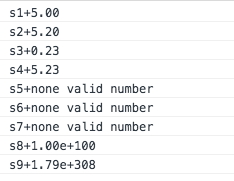看起来容易,但是有好多需要考虑到边界条件。
比如
1.如果含有正负号或者非数字字符怎么办?
2.最大正整数和最小负整数以及溢出
3.输入的字符不能转换成整数的时候,应该如何处理错误
所以其实还是比较复杂。不要看到题目就傻呵呵的写了。= =
JS 中有封装好的parseInt,但是传入的参数要注意:parseInt(string, radix)
1. 当radix<2 / radix > 36时,返回NaN
2.当string中的单个数字大于radix时,返回NaN
3.当radix===0 / 未设置时,根据string来判断
当string以‘0x’开头时,按照16进制解析
当string以‘0’开头时,按照八进制解析
当strign以‘1~9’开头时,按照十进制解析
拓展:(曾经跪在蚂蚁面试中的题)实现一个函数,把输入的数字保留两位小数,不进位,如果不足两位,以0补位。
function twoDecimal(num) { var res = ''; num = parseFloat(num); if (typeof num !== 'number' || isNaN(num) || !isFinite(num)) return 'none valid number'; else { var snum = num.toString(); var tail = '', e = snum.indexOf('e'); if (e != -1) { tail += snum.slice(e); snum = snum.slice(0, e); } var n = snum.split('.'); if (n.length === 1) { res += n + '.00'; } else { n[1] = n[1].length > 1 ? n[1].substr(0, 2) : n[1] + '0'; res = n[0] + '.' + n[1]; } return res + tail; } } var s1 = twoDecimal(5); console.log('s1+' + s1); var s2 = twoDecimal(5.2); console.log('s2+' + s2); var s3 = twoDecimal(0.232543); console.log('s3+' + s3); var s4 = twoDecimal('5.232543.099'); console.log('s4+' + s4); var s5 = twoDecimal(NaN); console.log('s5+' + s5); var s6 = twoDecimal('dskljaf'); console.log('s6+' + s6); var s7 = twoDecimal(Number.MAX_VALUE * 2); console.log('s7+' + s7); var s8 = twoDecimal(1e100); console.log('s8+' + s8); var s9 = twoDecimal(Number.MAX_VALUE); console.log('s8+' + s9);
输出结果:

如果哪里不对,还请老铁指正 :-)